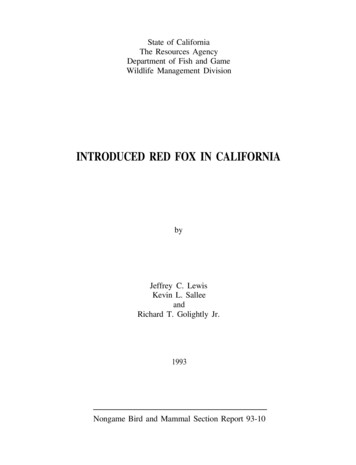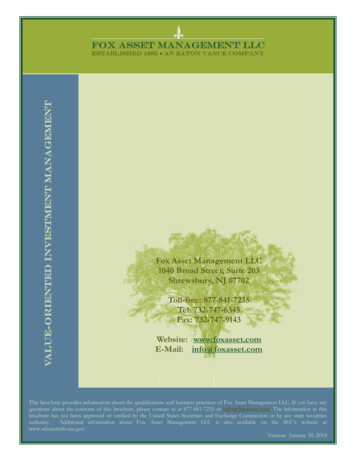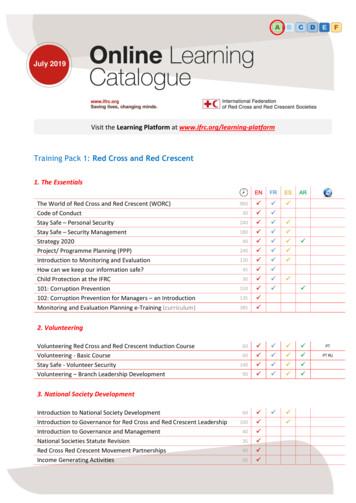
Transcription
State of CaliforniaThe Resources AgencyDepartment of Fish and GameWildlife Management DivisionINTRODUCED RED FOX IN CALIFORNIAbyJeffrey C. LewisKevin L. SalleeandRichard T. Golightly Jr.1993Nongame Bird and Mammal Section Report 93-10
FINAL REPORT TOCalifornia Department of Fish and Game1416 Ninth StreetSacramento, CA 95814CONTRACT FG8612 (FY90/92)Partially Supported by California Endangered Species IncomeTax Check-off Program (FY88/89); Pittman-Robertson FederalAid in Wildlife Restoration (FY90/91, W-65-R-8, Job V-l);and California Environmental License Plate Fund (FY91/92),Nongame Bird and Mammal Section, Wildlife Management Division.INTRODUCED RED FOX IN CALIFORNIACONTRACTORDepartment of Wildlife, Humboldt State UniversityArcata, CA 95521AUTHORSJeffrey C. LewisKevin L. SalleeandRichard T. Golightly Jr.
State of CaliforniaThe Resources AgencyDepartment of Fish and GameINTRODUCED RED FOX IN CALIFORNIAbyJeffrey C. LewisKevin L. SalleeandRichard T. Golightly Jr.Department of WildlifeHumboldt State UniversityArcata, CA 95521ABSTRACTIn a telephone survey of wildlife professionals inC a l i f o r n i a , introduced red fox were reported from 36 of 58 (62%)c o u n t i e s i n C a l i f o r n i a . The introduced red fox ranged along thePacific coast from southern San Diego County to Marin County.They were reported in western Riverside County northward throughthe Sacramento valley and western Sierra foothills to centralShasta County. P o p u l a t i o n s w e r e c o n t i g u o u s i n u r b a n a r e a s a n dmay be contiguous in rural areas as well. The diet of theintroduced red fox in the urban environment was diverse andconsisted of birds, mammals, insects, seeds, fruit and humanf o o d s . Among radio-collared foxes (n 23) in urban OrangeCounty, California, females had the greatest survival rate forboth juveniles and adults. Overall, dispersing juveniles had theg r e a t e s t m o r t a l i t y r a t e . Sources of mortality for urban foxesincluded collisions with autos, disease, an attack by a dog, anda c c i d e n t s o t h e r t h a n v e h i c l e c o l l i s i o n s . Juvenile males were themost likely to disperse. Average dispersal distance for alls u c c e s s f u l d i s p e r s e r s w a s 9 . 8 1 . 8 5 k m ( 6 . 1 1 . 1 5 m i . ) . Threeof the radio-collared foxes were known to have bred their firstyear. Average litter size was 4 pups per litter (n 7 litters)i n 1 9 9 1 a n d 3 p u p s p e r l i t t e r ( n 5 l i t t e r s ) i n 1 9 9 2 . Urbanfoxes were found to use all aspects of the urban environment,from open fields and beaches to residential developments.Corridors for travel for both resident and dispersing foxesincluded flood channels, beach strands, railroad tracks, andpowerline corriders. Red fox densities varied between sites.
TABLE OF CONTENTSIntroduction . . . . . . . . . . . . . . . . . . . . . . . . . . . . . . . . . . . . . . . . . . . . . . .Study Area . . . . . . . . . . . . . . . . . . . . . . . . . . . . . . . . . . . . . . . . . . . . . . . . .Methods . . . . . . . . . . . . . . . . . . . . . . . . . . . . . . . . . . . . . . . . . . . . . . . . . . . . .Red Fox Distribution . . . . . . . . . . . . . . . . . . . . . . . . . . . . . . . . . . . . .Red Fox Food Habits . . . . . . . . . . . . . . . . . . . . . . . . . . . . . . . . . . . . . .Population Information and Dispersal . . . . . . . . . . . . . . . . . . . . .Results . . . . . . . . . . . . . . . . . . . . . . . . . . . . . . . . . . . . . . . . . . . . . . . . . . . .Red Fox Distribution . . . . . . . . . . . . . . . . . . . . . . . . . . . . . . . . . . . . .Red Fox Food Habits . . . . . . . . . . . . . . . . . . . . . . . . . . . . . . . . . . . . . .Red Fox Population Information . . . . . . . . . . . . . . . . . . . . . . . . . . .Fox Capture and Tagging . . . . . . . . . . . . . . . . . . . . . . . . . . . . . . . .Survival . . . . . . . . . . . . . . . . . . . . . . . . . . . . . . . . . . . . . . . . . . . . . . .Mortality . . . . . . . . . . . . . . . . . . . . . . . . . . . . . . . . . . . . . . . . . . . . . .Density . . . . . . . . . . . . . . . . . . . . . . . . . . . . . . . . . . . . . . . . . . . . . . . .Dispersal . . . . . . . . . . . . . . . . . . . . . . . . . . . . . . . . . . . . . . . . . . . . . .Reproduction . . . . . . . . . . . . . . . . . . . . . . . . . . . . . . . . . . . . . . . . . . .Home Range and Land-Parcel Use . . . . . . . . . . . . . . . . . . . . . . . . . . .Movements . . . . . . . . . . . . . . . . . . . . . . . . . . . . . . . . . . . . . . . . . . . . . . . .Discussion . . . . . . . . . . . . . . . . . . . . . . . . . . . . . . . . . . . . . . . . . . . . . . . . .Red Fox Distributions . . . . . . . . . . . . . . . . . . . . . . . . . . . . . . . . . . . .State-wide Distribution . . . . . . . . . . . . . . . . . . . . . . . . . . . . . . . .Local Distribution . . . . . . . . . . . . . . . . . . . . . . . . . . . . . . . . . . . . .Population Characteristics . . . . . . . . . . . . . . . . . . . . . . . . . . . . . . .Density . . . . . . . . . . . . . . . . . . . . . . . . . . . . . . . . . . . . . . . . . . . . . . . .Dispersal . . . . . . . . . . . . . . . . . . . . . . . . . . . . . . . . . . . . . . . . . . . . . .Survival . . . . . . . . . . . . . . . . . . . . . . . . . . . . . . . . . . . . . . . . . . . . . . .Red Fox Use of Land and Food Resources . . . . . . . . . . . . . . . . . . .Use of Land Resources . . . . . . . . . . . . . . . . . . . . . . . . . . . . . . . . . .Use of Food Resources . . . . . . . . . . . . . . . . . . . . . . . . . . . . . . . . . .Summary . . . . . . . . . . . . . . . . . . . . . . . . . . . . . . . . . . . . . . . . . . . . . . . . . . . .Cooperators and Acknowledgements . . . . . . . . . . . . . . . . . . . . . . . . . . .Literature Cited . . . . . . . . . . . . . . . . . . . . . . . . . . . . . . . . . . . . . . . . . . .Tables . . . . . . . . . . . . . . . . . . . . . . . . . . . . . . . . . . . . . . . . . . . . . . . . . . . . .Figures . . . . . . . . . . . . . . . . . . . . . . . . . . . . . . . . . . . . . . . . . . . . . . . . . . . .Appendixes . . . . . . . . . . . . . . . . . . . . . . . . . . . . . . . . . . . . . . . . . . . . . . . . 262728344857
INTRODUCTIONIn California, the red fox (Vulpes vulpes) has beenreported to be native to the Sierra Nevada and southern CascadeM o u n t a i n s ( G r i n n e l l e t . a l . 1 9 3 7 ) . However, s i n c e t h e 1 8 9 0 ' s t h ered fox has been found in several areas of California which werenot part of its historical range (Grinnell et al. 1937); thesefoxes were probably fur farm escapees, fox hunt survivors, andintentionally-released pets or captives that have establishedbreeding populations. Based on morphological parameters, theintroduced foxes from the Sacramento Valley appear more closelyrelated to the Northern Great Plains subspecies of red fox (V. v.regalis) rather than the Sierra Nevada red fox (V. v. necator)(Roest 1977).Introduced red fox have established breeding populationsthroughout the Sacramento Valley (Gray 1975, 1977). Gould (1980)reported the range expansion of this population into Contra Costaand Alameda counties, a s w e l l a s a d d i t i o n a l s i g h t i n g s i n M a r i n ,S a n t a C r u z , V e n t u r a , and Los Angeles counties.Introduced red foxes are considered a threat to populationsof endangered wildlife including the light-footed clapper rail(Rallus lonagirostris levipes), the California clapper rail(Rallus longirostris obsoletus), the California least tern(Sterna antillarum browni), the salt marsh harvest mouse( R e i t h r o d o n t o m y s r a v i v e n t r i s ) , Belding's Savannah sparrow(Passerculus sandwichensis beldingi) (U. S. Fish and WildlifeService and U. S. Navy 1990, U . S . F i s h a n d W i l d l i f e S e r v i c e1990), a n d t h e S a n J o a q u i n k i t f o x ( V . m a c r o t i s m u t i c a ) ( R a l l se t . a l . 1 9 9 0 ) . The introduced red fox may also present a threatto the native Sierra Nevada red fox by competing for availablehabitat, interbreeding or transmitting diseases.Red fox trapping programs have been used as a means toprotect the California least tern and the light-footed clapperrail from predation, but have also created controversy (U. S.Fish and Wildlife Service and U. S. Navy 1990). In some urbanparks these foxes were treated as pets, and fed daily by people.In these same areas they may present health risks to the public.These concerns present difficult management problems.Information about introduced red foxes in California hasnot been avaliable for wildlife managers. To develop or assessmanagement alternatives to red fox control programs, a betterunderstanding of the ecology of red foxes was needed.Specifically, need existed to understand local sources ofdepredating red foxes, how they traveled to endangered-speciesn e s t i n g a r e a s , and the age of foxes that colonized on or nearthese areas. Sex-specific dispersal patterns, dispersaldistances, dispersal routes, rates of dispersal, timing ofdispersal, and dispersal direction needed to be investigated toanswer these questions. Further, identification of home range,f o o d h a b i t s , h a b i t a t u s e , and movement characteristics ofresident foxes would clarify the impact on native fauna.An investigation of the distribution of red fox sightingsthroughout California was necessary to assess the present rangeand population status. Determining the extent to which an
introduced species has become established was important inassessing or forecasting impacts on native species and habitats.Specific components of juvenile dispersal that wereaddressed in this study included: dispersal routes, dispersaldistances, mortality of dispersing and non-dispersing foxes,proportions of juveniles dispersing, and timing of dispersal.Specific home range and land-parcel use questions that wereaddressed included: age- and sex-specific home range size andland-parcel use of radio-collared foxes. Questions related tofood habits included; what food items were consumed by redfoxes?; and how consistant these items were found in the red foxdiet? Specific statewide distribution questions included: wherehave red foxes been sighted outside of the accepted range of then a t i v e S i e r r a N e v a d a r e d f o x ? ; and what was the range of theintroduced red fox in California?The California Department of Fish and Game (CDFG), Nongamesection, and the U. S. Fish and Wildlife Service (USFWS)cooperatively provided financial support for the project.2
STUDY AREAThe distribution of the introduced red fox was investigatedthroughout California except in areas inhabited by the SierraNevada red fox. The northwestern half of Orange County,California, was used as the study area for investigatingdispersal, home range and land-parcel use, mortality, survival,r e p r o d u c t i o n , a n d a g e s t r u c t u r e ( F i g u r e 1 ) . The study area wasbounded on the northwest by the San Gabriel River and CoyoteCreek flood channels, which delineate Orange County from LosAngeles County. It was bounded on the West by the Pacific Ocean,and to the North by California State Highway 91. T h e s t u d y a r e aincluded the Pacific coast from Seal Beach to Newport Beach, andincluded areas as far east as the cities of Tustin and Orange.This portion of Orange County was predominantly urban ands u b u r b a n i n n a t u r e a n d w a s i n t e r s p e r s e d w i t h o p e n s p a c e s . Theseopen spaces included golf courses, parks, airfields, cemeteries,wetlands, agricultural fields, powerline and highway corridors,and undeveloped lands.Much of Orange County (including the study area) is locatedi n t h e S o u t h e r n C a l i f o r n i a c o a s t a l p l a i n . Orange County has aMediterranean climate characterized by wet winters and drysummers. A v e r a g e a n n u a l r a i n f a l l w a s 3 2 . 0 c m ( 1 2 . 6 i n c h e s )(Kehew 1992). Mean temperatures ranged from 13.3 C (55.9 F) inJ a n u a r y t o 2 2 . 9 C (73.3 F) in August while the annual meantemperature was 17.8 C ( 6 4 . 0 F ) ( K e h e w 1 9 9 2 ) . T h e e l e v a t i o n o fthe study area ranged from sea level to approximately 100 m (328feet).Research activities were frequently located at specificsites within the study area and these areas warrant detailedd e s c r i p t i o n . Mile Square Park is administered as an Orange 2County Regional Park. I t i s o n e m i l e s q u a r e i n a r e a ( 2 . 2 5 k m )and includes a park and two privately-owned golf courses inF o u n t a i n V a l l e y , C a l i f o r n i a . Orange County Sewage TreatmentPlant #2 is an industrial facility with open space; the plant islocated adjacent to the Pacific coast at the mouth of the SantaA n a R i v e r i n H u n t i n g t o n B e a c h , C a l i f o r n i a . Bolsa ChicaEcological Reserve includes tidal salt marsh, grassy uplands, andscattered oil-pump sites and is located on the Pacific coast inH u n t i n g t o n B e a c h , C2a l i f o r n i a . 2 Los Alamitos Armed Forces ReserveCenter is an 8.0 km (3.0 mi ) military installation located northof Interstate Highway 405 in Los Alamitos, California. Itconsists of an airfield, open grasslands, agricultural lands, andtwo golf courses.3
METHODSRed Fox DistributionThe statewide distribution of the introduced red fox wasinvestigated by conducting telephone interviews with wildlifeprofessionals and related individuals throughout the state. Asighting was any red fox that had been seen in the field by theperson being interviewed or a red fox that the person had directknowledge of as a specimen (i.e., museum specimen). Eachtelephone interview sought to acquire information about each redfox sighting, including reliability, date, and location of thesighting. The reliability of a sighting was based on theexperience that the interviewed individual had with red foxes,and/or the accuracy of the description of the reported animal.F o r e f f i c i e n c y , new locations were mapped only if they were atleast 1.6 km (1 mile) distant from the nearest previouslyreported location.Presently, no reliable means is available to visuallydistinguish the native Sierra Nevada red fox from the introducedred fox. Therefore, interviewing efforts were concentrated inareas outside of the historical range of the Sierra Nevada redfox as reported by Grinnell et al. (1937). Consequently, no redfox sightings above 1066 m (3500 ft.) in the Sierra or CascadeRanges were included in the distribution. With the exception ofOrange County and two sightings acquired from letters thatincluded photographs of the red foxes, sightings were collectedonly by telephone interview. In Orange County, historicalr e f e r e n c e s ( e . g . , reports and books) were also used indetermining distribution within that one county.Red Fox Food HabitsFood habits were investigated by collecting fox fecalmaterial (scat) once each month from specific sites. Collectionsites were cleared of scat during each collection; thussubsequent collections contained only recent (since lastc o l l e c t i o n ) s c a t d e p o s i t i o n . This allowed assessment of seasonalvariation in fox food habits. Scats were air-dried and shippedto the Humboldt State University (HSU) Department of Wildlife.Upon arrival at HSU, s c a t s w e r e f r o z e n u n t i l a n a l y s i s .Fecal samples were randomly chosen from within each monthlyc o l l e c t i o n a t e a c h c o l l e c t i o n s i t e . Samples (11-13g: 3-5 fecaldeposits) were washed and the remaining insolubles were thenoven-dried. The oven-dried samples were stored in a desiccatoru n t i l a n a l y z e d . Samples were separated into food items bysimilar groups of fragments (i.e., feathers, seeds, hair, bones,e t c . ) w i t h t h e a i d o f a d i s s e c t i n g m i c r o s c o p e . Each sample wassearched until all identifiable fragments had been separated, orfor a maximum of 2 hours. Usual search time was approximately 1hour.4
Additional samples from a single collection continued untilno new prey items were found in succeeding samples. Once foodremains were separated they were identified using reference texts( I n g l e s 1 9 6 5 , Swanson and Papp 1972) and mammalian, avian,i n v e r t e b r a t e , a n d p l a n t r e f e r e n c e c o l l e c t i o n s a t H S U . We wereassisted by the U. S. Department of Agriculture and the San DiegoM u s e u m o f N a t u r a l H i s t o r y i n t h e i d e n t i f i c a t i o n o f s e e d s . Onceidentified, food items were summed by season, food type, andspecific food item.Population Information and DispersalRed foxes were captured and radio-collared (Mod 300 collar,Telonics, Mesa, AZ) to obtain location data for determining homer a n g e , h a b i t a t u s e , a r i d d i s p e r s a l . Tomahawk box (cage) traps(121 cm by 68 cm by 52 cm, or 107 cm by 41 cm by 41 cm, or 81 cmby 33 cm by 28 cm; Tomahawk Live Trap Co., Tomahawk, WI) wereu s e d i n a l l t r a p p i n g . Degree of wear on incisors was used as aprimary indicator of age (Harris 1978), and weight and coatcondition were used as secondary age indicators. For thepurposes of this study, distinguishing between adults andjuveniles was adequate.Each radio-collared fox was identifiable by the individualmarkings on its ear tags and radio-collar. Colored reflectivetape was placed on the ear tags and radio-collar so thatindividual animals had a unique color combination (e.g., red tagi n r i g h t e a r , b l u e t a g i n l e f t e a r ) . Color-coded ear tags andradio-collars allowed other biologists and lay individualsw i t h o u t r a d i o - r e c e i v e r s t o i d e n t i f y i n d i v i d u a l f o x e s . Thecolored reflective tape could be seen at a 150 m distance atnight with a spotlight, or during the day.Survival and mortality rates of radio-collared foxes wereestimated using the Micromort computer program (Heisey and Fuller1985). T h e i n t e r v a l o v e r w h i c h s u r v i v a l r a t e w a s e s t i m a t e d f o rjuveniles began on 9 July (earliest radio-collaring) andcontinued for 250 days until 15 March, which was the estimatedwhelping date for observed litters. For adults, a 365-dayinterval was used (15 March - 14 March). S u r v i v a l a n d m o r t a l i t yrates were estimated age- and sex-specifically for dispersers andl-year olds, and for juveniles captured in July. Mortality rateswere estimated cause-specifically.Midnight spotlight surveys were conducted at Los AlamitosArmed Forces Reserve Center and Mile Square Park to assesspopulation size and trends at these two northwestern OrangeC o u n t y s i t e s . All observed red foxes were counted and thep r e s e n c e o r a b s e n c e o f a t a g o r c o l l a r w a s r e c o r d e d . Surveyroutes were chosen to minimize the possibility of recounting anyindividuals seen while the observer drove once along apredetermined route through the site.Dispersal characteristics were determined for individualsthat moved away from established home ranges or natal sites.5
When a radio-collared individual could not be located, a searchw a s c o n d u c t e d t o l o c a t e i t s r a d i o s i g n a l . This was continueduntil the individual was found or considered missing (afterextensive searches). Once the animal was found, the direction ofdispersal from the original home range (or den site forjuveniles) and the straight-line distance was recorded. Radiotelemetry locations were obtained at the rate of three locationsper week in the new home range (which was calculated as distinctfrom the pre-dispersal home range).Home range and land-parcel use by foxes were determined byobtaining at least three independent locations per week perindividual fox. Adults and juveniles were followed to observet e m p o r a l l a n d - p a r c e l u s e a n d m o v e m e n t r a t e s . The Mcpaal computerprogram (Stuwe and Blohowiak 1985) was used to generate MinimumConvex Polygon (MCP) (Harvey and Barbour 1965) and Harmonic MeanTransformation (HMT) (Dixson and Chapman 1980) estimates of homer a n g e s i z e . All HMT estimates were based on a calculation using15 grid divisions and 95% of the locations.Juveniles were considered adults when they survived to 15March. I f a f o x d i d n o t d i s p e r s e , t h e t o t a l n u m b e r o f l o c a t i o n sas a juvenile and adult were included when estimating their adulthome range. However, dispersing juveniles had two home ranges.; ajuvenile home range prior to dispersal and an adult home rangea f t e r d i s p e r s a l . This methodology caused a loss of independencebetween non-dispersing juvenile and adult home ranges so no testsbeyond the average home range size of each group was performed.Different features of the urban environment, such asresidential areas, open fields, parks, etc., were categorized asdifferent land-parcel types. Any land-parcel type or types thatwere separated only by a road, flood channel, or other thinb a r r i e r w e r e c o n s i d e r e d c o n t i g u o u s . A patch of open space wasconsidered to consist of the total area of contiguous landparcels exclusive of residential and retail business development.Home range size in comparison to the amount of open space wasinvestigated using linear correlation (Zar 1984). The areas ofland parcels were calculated from color aerial photographs(1:17400; Airborne Systems, Anaheim, CA).Movement patterns of red foxes were determined by continualtracking of collared animals. Because constant surveillance ofcollared foxes was usually difficult, movement information wasgathered by analyzing relocations collected as frequently asp o s s i b l e . However, s a m p l i n g t e c h n i q u e s o t h e r t h a n c o n s t a n tsurveillance cannot fully describe a fox's movement during asingle time period.6
RESULTSRed Fox DistributionTelephone interviews were conducted with 199 individuals.Of these, 125 individuals (63%) had sightings of red foxes.These individuals produced 319 sightings of introduced red fox(below 1066 m or 3500 ft. in elevation) (Table 1, Figure 2, andAppendix 1). R e d f o x e s a r e e x t r e m e l y m o b i l e , c a n t r a v e l l a r g edistances in a short period of time, and can have large homeranges. Locations do not infer the presence of reproductive orlarge established populations nor do locations infer density ortiming of colonization of certain areas; however in some areasthe density of locations may be grossly associated with ageneralized (and perhaps dense) fox population.Red fox sightings were recorded in the coastal areas fromMission Bay just north of San Diego in San Diego County to PointReyes National Seashore in Marin County. Red foxes were sightedthroughout the San Joaquin and Sacramento Valleys from an areaextending from Bakersfield in Kern County northward to theWhiskeytown National Recreation Area in Shasta County. S i g h t i n g swere reported as far east as western Riverside County and thewestern Sierra Nevada foothills (below 1066 m or 3500 ft.) in ElDorado, Madera, Fresno, Placer and Tulare Counties. O t h e rsightings were reported in the Salinas River Valley in Montereyand San Luis Obispo Counties, i n t h e C a r r i z o P l a i n i n S a n L u i sObispo County, and in the San Francisco Bay Area in Alameda,Contra Costa, Santa Clara, and San Mateo Counties. A d d i t i o n a lsightings for the North Bay and Delta region occurred in Solano,Napa and Sonoma Counties. N o s i g h t i n g s w e r e r e c o r d e d f o r t h ecoastal area between northwestern Santa Barbara County andMonterey Bay in Monterey County.Excluding the Sierra and Cascade foothills, red foxes werereported at relatively high elevations in some counties.Sightings were reported as high as 750 m in the coastal ranges inSan Luis Obispo county, and 800 m in Santa Clara County. Maximumelevations of 1000 m and 1100 m were recorded for sightings inthe San Gabriel mountains in Los Angeles County and the SanJacinto Mountains in Riverside County, respectively.Two red fox sightings occurred near Fall River Mills innortheastern Shasta County; t h e s e s i g h t i n g s w e r e l o c a t e d d i r e c t l ybetween the 2 northern most portions of the historical SierraNevada red fox range. B e c a u s e o f t h e u n c e r t a i n t y o f t h etaxonomic status of these foxes they were not included in thestatewide distribution map (Figure 2). In the Sierra Nevada andCascade Ranges, only sightings that occurred below 1066 m (3500ft.) in elevation were considered to be observations of theintroduced red fox. Sightings of red fox above this elevation inthe Sierra and Cascade Ranges were not included in the statewidedistribution of introduced red fox.The distribution of introduced red foxes in Orange Countyw a s a l s o i n v e s t i g a t e d i n d e t a i l ( A p p e n d i x 2 ) . Twenty-two den7
sites and 39 independent sightings were reported in Orange County(Figure 3). P r i o r t o t h i s r e p o r t , t h e s c i e n t i f i c l i t e r a t u r e h a dnot reported red foxes in Orange County (Grinnell et al. 1937,Hall and Kelson 1959, Ingles 1965), however we recorded sightingsin Orange County as early as 1942 and 1965. O n l y d e n s i t e sgreater than 1.6 km (1 mile) away from previously mapped densites were added to the distribution of den sites in OrangeCounty. A l l d e n s i t e s , a n d 3 5 o f t h e 3 8 i n d e p e n d e n t s i g h t i n g soccurred in urban areas; urban areas were characterized byresidential, industrial, commercial, or similarly developed areasw i t h i n t e r s p e r s e d o p e n s p a c e s a n d c o r r i d o r s . These landscapefeatures characterized much of northern Orange County.Red Fox Food HabitsFox scats were collected approximately once a month from 7sites in Orange County (Table 2). Scat was collected once atSeal Beach NWR and Costa Mesa High School.From the 7 collection sites, 447 fecal samples(approximately 1800 scats) over all seasons were analyzed.I n s e c t s , s e e d s , b i r d s , m a m m a l s , and human-food packaging werer e g u l a r l y i n g e s t e d . Invertebrates, seeds, birds, and mammalswere each found in 50% of the samples, regardless of season(Table 3, F i g u r e 4 ) . W h i l e a n a t i d s a n d p a s s e r i n e s w e r e t h e m o s tfrequently found avian food items in scat samples, their percentoccurrence was greatest in the summer and fall samples (Table 4).Pocket gophers (Geomyidae) were the most frequently encounteredmammalian food item regardless of the season (Table 5).Invertebrates in scats included insects (6 orders), arachnids,c r u s t a c e a n s , and mollusks (Appendix 3). S e e d s o c c u r r i n g i n s c a t sincluded 44 genera in 28 plant families (Appendix 4). Mosts e e d s w e r e c o n s u m e d a s p a r t o f a p l a n t f r u i t . Aluminum foil,p l a s t i c , and paper were the most frequently found human foodpackaging and were consistently found in the samples. Eggshellswere found in all seasons.Opportunistically acquired food was difficult to quantifyor observe due to limited access to certain areas (e.g., petf o o d - d i s h e s i n b a c k y a r d s ) . However, r e g u l a r f e e d i n g o f f o x e s b ypeople was consistent in some areas and was thus measurable. AtMile Square Park a single individual provided anaverage of 7.12 0.033 kg (mean standard error) of food perday (measured during a 48 day period) to the approximately 40foxes at Mile Square Park (which equates to 0.177 kg/fox-day).Food provided at this site consisted of beef, chicken, turkey,and fish.Additional food habits data were collected by observationsof predation, and identifying remains at red fox cache sites andden entrances (Table 6). Only vertebrate species were identifiedat den entrances. Seven species of birds that were notidentified in the scats were found at dens. These included gulls( L a r u s s p . ) , a marbled godwit (Limosa fedoa), house sparrow8
( P a s s e r d o m e s t i c u s ) , mourning dove (Zenaida macroura), crow(Corvus sp.), cormorant (Phalacrorax sp.) and American avocet(Recurvirostra americana).Red Fox Population Information and DispersalFox Capture and TaggingFrom June 1990 to March 1992 red foxes were captured andradio-collared at 8 different sites. A total of 33 red foxeswere captured including 18 juveniles and 15 adults (excluding afox family removed by the CDFG from the 55-freeway in May1991) (Appendix 5). A t o t a l o f 2 3 f o x e s w e r e r a d i o - c o l l a r e d a n de a r - t a g g e d ( 1 5 j u v e n i l e s a n d 8 a d u l t s ) . The remaining 10 wereear-tagged (3 juveniles and 7 adults, all at Mile Square Park).Each radio-collared and ear-tagged fox appeared to be in goodcondition and was released unharmed.Of the 23 foxes, 1 8 w e r e c a p t u r e d i n b a i t e d b o x t r a p s . T h eremaining 5 foxes were captured by chasing them out of a 75 mlong culvert (used by these foxes as a diurnal resting area) intou n b a i t e d b o x t r a p s . From June 1990 to January 1991, 15 foxeswere captured using box-traps in 444 trap nights (3.38% traps u c c e s s ) . The three foxes caught from July 1991 to March 1992were captured in 67 trap nights following 341 pre-bait nights(4.48% trap success) (Table 7). There were 17 recaptures duringthe two-year period.SurvivalFifteen radio-collared juveniles (11 in 1990 and 4 in 1991)were followed over a portion of their first year (Figure 5).Seven of these were captured in July. The remainder of theThejuveniles were captured between September and January.survival rate was lowest for dispersing juveniles (all Julycaptures). No juvenile female mortalities were observed; theirsurvival was 100%. S m a l l s a m p l e s i z e ( n 6 ) m a y c o n t r i b u t e t othe result; however, l
Service and U. S. Navy 1990,U. S. Fish and Wildlife Service 1990), and the San Joaquin kit fox(V. macrotis mutica) (Ralls et. al. 1990).The introduced red fox may also present a threat to the native Sierra Nevada red fox by competing for available habitat, interbreeding or transmitting diseases. Red fox trapping programs have been used as a .










